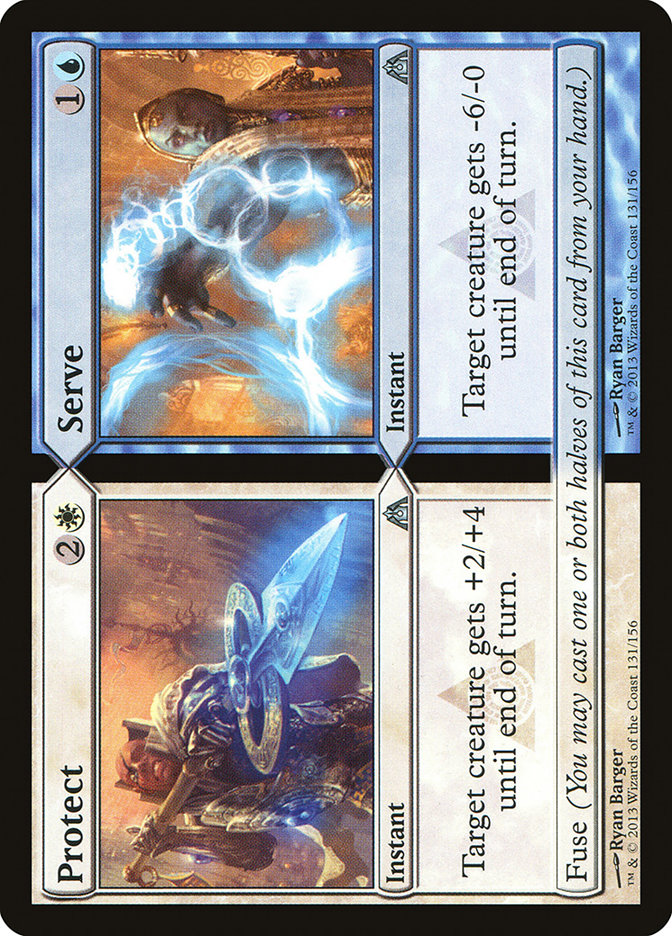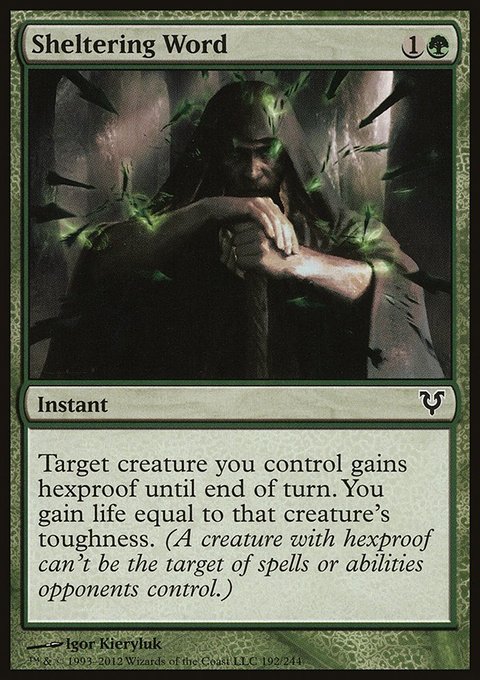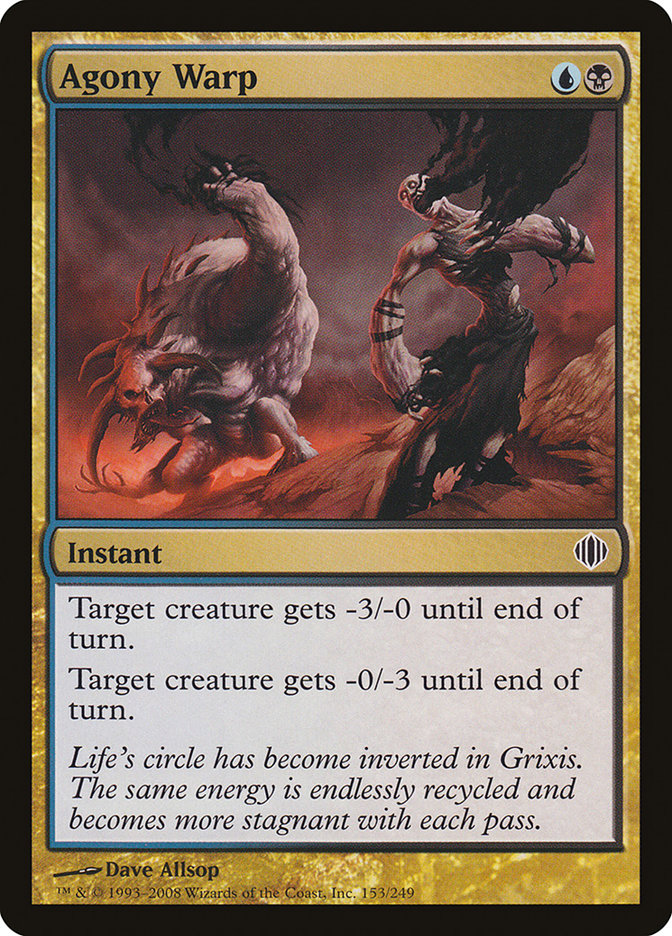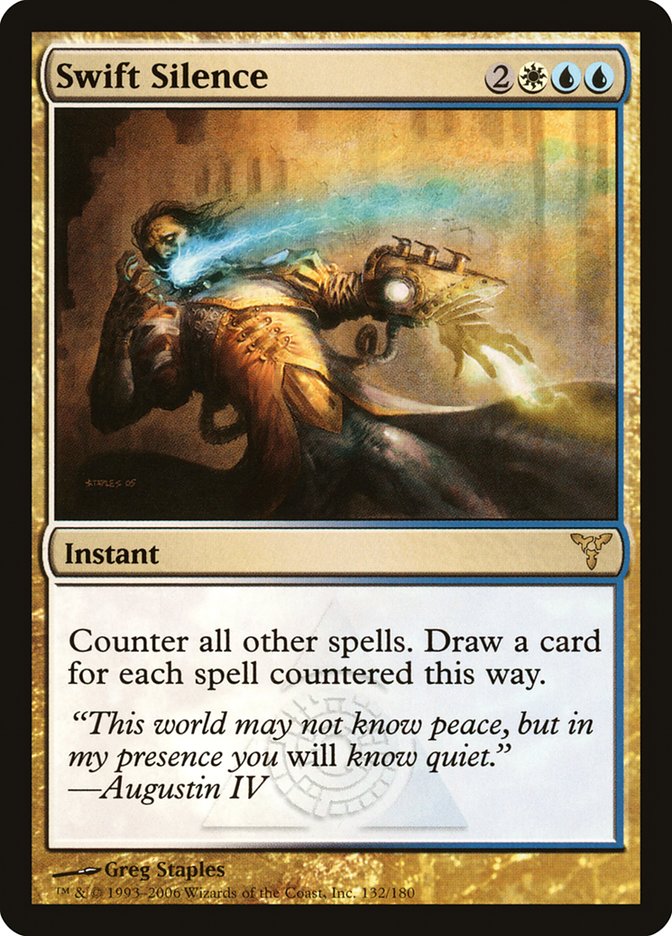Protect // Serve MTG Card
| Mana cost | |
| Converted mana cost | 5 |
| Rarity | Uncommon |
| Type | Instant |
| Abilities | Fuse |
| Released | 2013-05-03 |
| Set symbol | |
| Set name | Dragon's Maze |
| Set code | DGM |
| Number | 131 |
| Frame | 2003 |
| Layout | Split |
| Border | Black |
| Illustred by | Ryan Barger |
Text of card
Target creature gets -6/-0 until end of turn. Fuse (You may cast one or both halves of this card from your hand.)
Cards like Protect // Serve
Protect // Serve is a unique split card in MTG that offers versatility and strategic depth. Its closest relative in terms of protective spells is Sheltering Word. Both cards provide a safety net; however, Protect // Serve has the upper hand with its dual functionality. Sheltering Word specifically targets one creature, granting it hexproof and life gain, a clear contrast to Protect’s ability to shield any creature from damage with an increase in toughness.
Turning attention to Serve, we see parallels with spells like Agony Warp. Both can weaken an opponent’s creature, but Serve stands apart with its precise control over toughness, potentially saving a player’s creature in a tight spot. Agony Warp’s split between toughness reduction and power can sometimes be less impactful when mitigating incoming damage.
To sum up, Protect // Serve stands out amongst similar MTG cards due to its split nature, allowing players to choose their path, be it defense or debuff. In contingency situations, this duality proves especially potent, demonstrating why Protect // Serve is a card worthy of consideration in decks that prize flexibility and tactical plays.
Cards similar to Protect // Serve by color, type and mana cost
Card Pros
Card Advantage: The split nature of Protect // Serve offers flexibility, implying you can either bolster your creatures or weaken an adversary’s threats to optimize the cards in your hand.
Resource Acceleration: Despite not directly producing mana or tokens, efficient utilization of Protect can save your pivotal creatures during combat, effectively maintaining your board presence and conserving resources for subsequent turns.
Instant Speed: As an instant, Protect // Serve can be deployed at the most opportune moment, potentially catching opponents off-guard and turning the tide of battle in your favor without having to commit to a play before having full information.
Card Cons
Discard Requirement: One potential downside of using Protect // Serve is the necessity to have another card to discard when leveraging its Fuse ability. This can present a challenge when your hand is already depleted, forcing you to weigh the benefits of the spell against the loss of another valuable resource in your arsenal.
Specific Mana Cost: Each half of Protect // Serve comes with a specific mana requirement—white for Protect and blue for Serve. This can constrain deck-building options, making it less versatile for those who do not run a deck that can easily accommodate both mana types.
Comparatively High Mana Cost: When considering its combined mana cost for fusing, Protect // Serve may fall short in efficiency. There are instances when the total mana investment does not match up with the impact provided by the spell, leaving players to ponder if their mana could be better spent on alternatives with a stronger or more immediate influence on the battlefield.
Reasons to Include in Your Collection
Versatility: Protect // Serve offers two distinct abilities in a single card, granting flexibility in both aggressive and defensive strategies. As a fuse card, it can adapt to different situations, saving your creatures or weakening an opponent’s offense.
Combo Potential: Its potential to alter combat math significantly enhances combos, particularly in decks that capitalize on life total differences. The ‘Serve’ half can be especially potent in decks that reward life gain or exploit opponents’ life loss.
Meta-Relevance: Given its ability to function as a combat trick or life balance swayer, it has relevance in a meta that prioritizes creature-based strategies. Whether it’s giving your creature an edge against tougher opponents or ensuring your survival against aggressive decks, Protect // Serve has a place in the ever-evolving competitive scene.
How to Beat
Tackling the unique dynamic of Protect // Serve in the realm of MTG challenges players to adapt and strategize effectively. This split card opens up two avenues: Protect offers a boon to your creatures’ toughness, while Serve can weaken an opponent’s creature significantly. Understanding the dual nature of the card is key to formulating a counter strategy.
To counteract the defensive prowess of Protect, consider using spells that don’t rely on damage to remove creatures, such as those that force sacrifices or exiling effects. Cards like Path to Exile or Fatal Push can efficiently bypass the toughness boost. On the flip side, to lessen the impact of Serve, playing creatures with higher base toughness or utilizing instant-speed buffs can preserve your critical creatures from being undermined.
Moreover, utilizing counter magic effectively during critical phases can prevent the card from resolving, nullifying its influence on the board state. Cards like Counterspell or Dovin’s Veto are excellent examples. In essence, disrupting the timing and application of Protect // Serve can turn the tides in your favor during a match.
Where to buy
If you're looking to purchase Protect // Serve MTG card by a specific set like Dragon's Maze, there are several reliable options to consider. One of the primary sources is your local game store, where you can often find booster packs, individual cards, and preconstructed decks from current and some past sets. They often offer the added benefit of a community where you can trade with other players.
For a broader inventory, particularly of older sets, online marketplaces like TCGPlayer, Card Kingdom and Card Market offer extensive selections and allow you to search for cards from specific sets. Larger e-commerce platforms like eBay and Amazon also have listings from various sellers, which can be a good place to look for sealed product and rare finds.
Additionally, Magic’s official site often has a store locator and retailer lists for finding Wizards of the Coast licensed products. Remember to check for authenticity and the condition of the cards when purchasing, especially from individual sellers on larger marketplaces.
Below is a list of some store websites where you can buy the Protect // Serve and other MTG cards:
 BUY NOW
BUY NOW BurnMana is an official partner of TCGPlayer
- eBay
- Card Kingdom
- Card Market
- Star City Games
- CoolStuffInc
- MTG Mint Card
- Hareruya
- Troll and Toad
- ABU Games
- Card Hoarder Magic Online
- MTGO Traders Magic Online
See MTG Products
Legalities
Magic the Gathering formats where Protect // Serve has restrictions
| Format | Legality |
|---|---|
| Commander | Legal |
| Legacy | Legal |
| Modern | Legal |
| Oathbreaker | Legal |
| Vintage | Legal |
| Duel | Legal |
| Pioneer | Legal |
| Penny | Legal |
Rules and information
The reference guide for Magic: The Gathering Protect // Serve card rulings provides official rulings, any errata issued, as well as a record of all the functional modifications that have occurred.
| Date | Text |
|---|---|
| 2013-04-15 | If a player names a card, the player may name either half of a split card, but not both. A split card has the chosen name if one of its two names matches the chosen name. |
| 2013-04-15 | If you cast a split card with fuse from your hand without paying its mana cost, you can choose to use its fuse ability and cast both halves without paying their mana costs. |
| 2013-04-15 | If you’re casting a split card with fuse from any zone other than your hand, you can’t cast both halves. You’ll only be able to cast one half or the other. |
| 2013-04-15 | On the stack, a split spell that hasn’t been fused has only that half’s characteristics and converted mana cost. The other half is treated as though it didn’t exist. |
| 2013-04-15 | Some split cards with fuse have two halves that are both multicolored. That card is multicolored no matter which half is cast, or if both halves are cast. It’s also multicolored while not on the stack. |
| 2013-04-15 | Some split cards with fuse have two monocolor halves of different colors. If such a card is cast as a fused split spell, the resulting spell is multicolored. If only one half is cast, the spell is the color of that half. While not on the stack, such a card is multicolored. |
| 2013-04-15 | To cast a fused split spell, pay both of its mana costs. While the spell is on the stack, its converted mana cost is the total amount of mana in both costs. |
| 2013-04-15 | When a fused split spell resolves, follow the instructions of the left half first, then the instructions on the right half. |
| 2013-04-15 | When resolving a fused split spell with multiple targets, treat it as you would any spell with multiple targets. If all targets are illegal when the spell tries to resolve, the spell doesn’t resolve and none of its effects happen. If at least one target is still legal at that time, the spell resolves, but an illegal target can’t perform any actions or have any actions performed on it. |
| 2013-04-15 | You can choose the same object as the target of each half of a fused split spell, if appropriate. |




